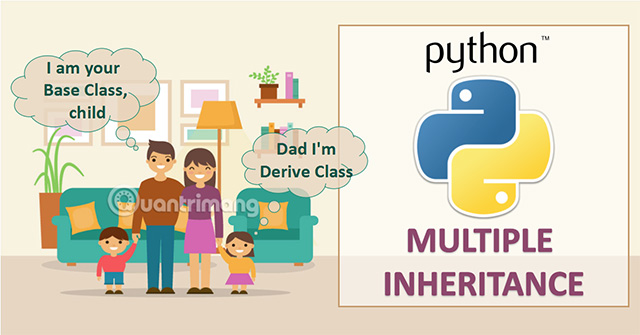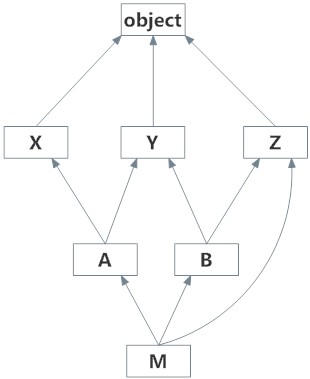Multiple Inheritance in Python
In the previous lesson, we learned about Inheritance in object-oriented programming of Python language. Inheritance allows us to declare the new class to re-use the parent class's functions and attributes and extra functions. In this article, Quantrimang will continue the lesson with the theme Inheritance but at a deeper level, which is the Inheritance and the order of method access of the parent classes (Method Resolution Order).

Multiple Inheritance
Like C ++, in Python a class can be defined from multiple parent classes. This is called multiple inheritance.
Syntax:
class LopCha1:
pass
class LopCha2:
pass
class LopCon(LopCha1, LopCha2):
pass

Subclasses are defined from multiple parent classes and inherit the characteristics of both classes.
Parent classes can have the same properties or methods. The subclass will prioritize inheriting the attribute, the class method is first in the inheritance list.
Multi-level inheritance (Multilevel Inheritance)
In addition to being able to inherit from parent classes, you can also create new subclasses that inherit previous subclasses. This is called multi-level inheritance (Multilevel Inheritance).
In this case, the properties of the parent class and the previous subclass will be inherited by the new subclass.
Syntax:
class LopCha:
pass
class LopCon1(LopCha):
pass
class LopCon2(LopCon1):
pass

LopCon1 inherits LopCha, LopCon2 inherits LopCon1.
Method Resolution Order (Method Resolution Order)
Class is derived from object. In a multiple inheritance scenario, any attributes that need to be retrieved will first be searched in the current class. If not found, search continues to the first parent class and left to right.
So the order of access will be [LopCon, LopCha1, LopCha2, object].
This order is also called linearization of LopCon and the set of rules used to find this order is called the Method Access Order (MRO).
In simple terms, MRO is used to display lists / tuples of parent classes of a particular class.
MRO is used in two ways:
- __mro__: returns a tuple
- mro (): returns a list.
>>> LopCon.__mro__
( ,( ,
,
,
)
>>> LopCon.mro()
[ ,[ ,
,
,
]
Here is a complex inheritance example and its visual display along with the MRO.

class X: pass
class Y: pass
class Z: pass
class A(X,Y): pass
class B(Y,Z): pass
class M(B,A,Z): pass
# Output:
# [ , ,# [ , ,# [ , ,
# , ,# , ,# , ,
# , ,# , ,# , ,
# ]# ]
See more:
- More than 100 Python exercises have solutions (sample code)
- Free online Python interpreter
- Some tools run Python on Android
Last lesson: Inheritance (Inheritance) in Python
Next lesson: Overload operator in Python
You should read it
- Calculate inheritance in C #
- What is Python? Why choose Python?
- Multiple choice quiz about Python - Part 1
- 5 choose the best Python IDE for you
- Multiple choice quiz about Python - Part 3
- More than 100 Python exercises have solutions (sample code)
- Why should you learn Python programming language?
- Multiple choice test on Python - Part 11
May be interested
- Multiple choice quiz about Python - Part 9
 how much do you know about python functions? keep testing your knowledge with quantrimang through the following multiple choice questions!
how much do you know about python functions? keep testing your knowledge with quantrimang through the following multiple choice questions! - Multiple choice quiz about Python - Part 7
 following the previous test set, part 7 continues with the topic built-in functions in python. let's try with quantrimang to try the 10 questions below.
following the previous test set, part 7 continues with the topic built-in functions in python. let's try with quantrimang to try the 10 questions below. - Multiple choice quiz about Python - Part 10
 following the previous test, part 10 returned with the python function. let's try with quantrimang to try the 10 questions below.
following the previous test, part 10 returned with the python function. let's try with quantrimang to try the 10 questions below. - Class inheritance in Python (P1)
 classes along with objects are the core components of python. classes provide a way to organize attributes (data) and methods (behaviors). let's explore them further.
classes along with objects are the core components of python. classes provide a way to organize attributes (data) and methods (behaviors). let's explore them further. - Multiple choice quiz about Python - Part 5
 if you are interested in learning about the python programming language, the following quiz of network administrator will provide useful knowledge for your learning.
if you are interested in learning about the python programming language, the following quiz of network administrator will provide useful knowledge for your learning. - Model Inheritance là gì trong Django?
 inheritance - kế thừa cho phép bạn dùng lại code và tạo mẫu dữ liệu gọn gàng hơn. thế nhưng django cung cấp nhiều hơn một cách để kế thừa, vì thế, đảm bảo bạn biết rõ các điểm khác biệt.
inheritance - kế thừa cho phép bạn dùng lại code và tạo mẫu dữ liệu gọn gàng hơn. thế nhưng django cung cấp nhiều hơn một cách để kế thừa, vì thế, đảm bảo bạn biết rõ các điểm khác biệt. - More than 100 Python exercises have solutions (sample code)
 more than 100 python code examples are shared by guy zhiwehu on github, however, the solution of this series is written on the old python version. following tipsmake.com will be vietnameseized and edited to suit python 3.x to help you learn and practice python.
more than 100 python code examples are shared by guy zhiwehu on github, however, the solution of this series is written on the old python version. following tipsmake.com will be vietnameseized and edited to suit python 3.x to help you learn and practice python. - Bookmark 5 best Python programming learning websites
 if you are a developer or you are studying and want to stick with this industry, learn python to add a highlight in your journey.
if you are a developer or you are studying and want to stick with this industry, learn python to add a highlight in your journey. - For in Python loop
 in this article, we will learn more about for for loop in python as well as its variations, how to use for to repeat a string of elements in python such as list, string or other iterative objects.
in this article, we will learn more about for for loop in python as well as its variations, how to use for to repeat a string of elements in python such as list, string or other iterative objects. - Manage files and folders in Python
 python also provides a variety of methods to handle various directory-related operations. in this article, we will learn about managing files and directories in python, namely creating folders, renaming folders, listing folders and working with them.
python also provides a variety of methods to handle various directory-related operations. in this article, we will learn about managing files and directories in python, namely creating folders, renaming folders, listing folders and working with them.










 Programming blockchain part 3: Python programming language
Programming blockchain part 3: Python programming language Stack operator in Python
Stack operator in Python Complex () function in Python
Complex () function in Python The compile () function in Python
The compile () function in Python The delattr () function in Python
The delattr () function in Python The dict () function in Python
The dict () function in Python